MSI B85M ECO Review: Aiming Green at $73
by Ian Cutress on November 26, 2014 8:00 AM EST- Posted in
- Motherboards
- MSI
- B85
- ECO
CPU Benchmarks
Readers of our motherboard review section will have noted the trend in modern motherboards to implement a form of MultiCore Enhancement / Acceleration / Turbo (read our report here) on their motherboards. This does several things, including better benchmark results at stock settings (not entirely needed if overclocking is an end-user goal) at the expense of heat and temperature. It also gives in essence an automatic overclock which may be against what the user wants. Our testing methodology is ‘out-of-the-box’, with the latest public BIOS installed and XMP enabled, and thus subject to the whims of this feature. It is ultimately up to the motherboard manufacturer to take this risk – and manufacturers taking risks in the setup is something they do on every product (think C-state settings, USB priority, DPC Latency / monitoring priority, memory subtimings at JEDEC). Processor speed change is part of that risk, and ultimately if no overclocking is planned, some motherboards will affect how fast that shiny new processor goes and can be an important factor in the system build.
For reference, the B85M ECO does not have any form of MultiCore Turbo.
Point Calculations – 3D Movement Algorithm Test: link
3DPM is a self-penned benchmark, taking basic 3D movement algorithms used in Brownian Motion simulations and testing them for speed. High floating point performance, MHz and IPC wins in the single thread version, whereas the multithread version has to handle the threads and loves more cores.
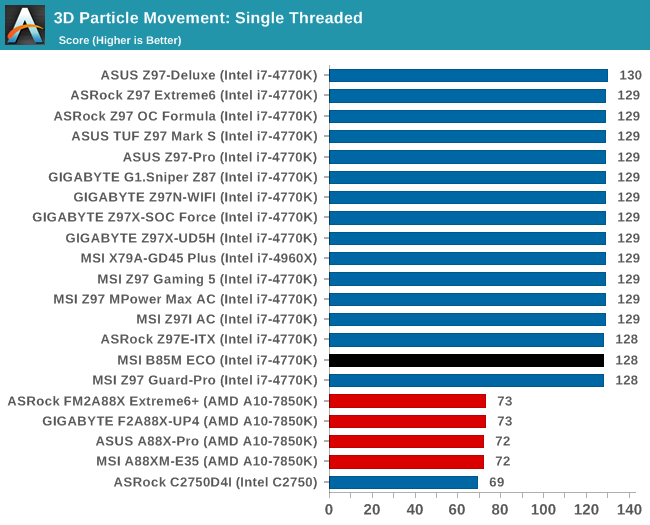
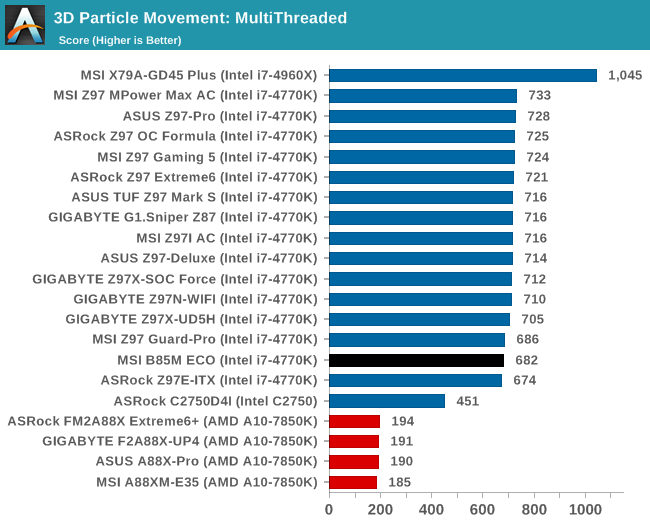
Compression – WinRAR 5.0.1: link
Our WinRAR test from 2013 is updated to the latest version of WinRAR at the start of 2014. We compress a set of 2867 files across 320 folders totaling 1.52 GB in size – 95% of these files are small typical website files, and the rest (90% of the size) are small 30 second 720p videos.
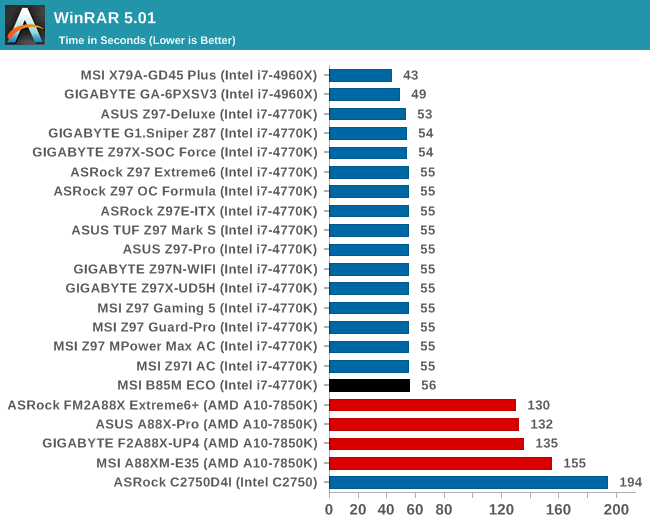
Image Manipulation – FastStone Image Viewer 4.9: link
Similarly to WinRAR, the FastStone test us updated for 2014 to the latest version. FastStone is the program I use to perform quick or bulk actions on images, such as resizing, adjusting for color and cropping. In our test we take a series of 170 images in various sizes and formats and convert them all into 640x480 .gif files, maintaining the aspect ratio. FastStone does not use multithreading for this test, and thus single threaded performance is often the winner.
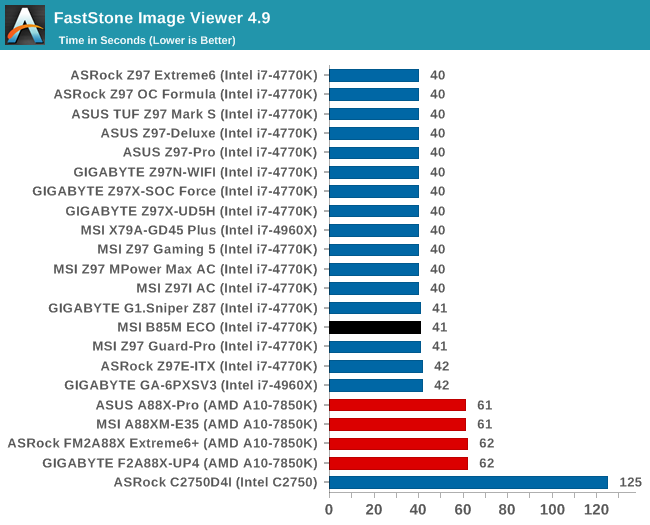
Video Conversion – Handbrake v0.9.9: link
Handbrake is a media conversion tool that was initially designed to help DVD ISOs and Video CDs into more common video formats. The principle today is still the same, primarily as an output for H.264 + AAC/MP3 audio within an MKV container. In our test we use the same videos as in the Xilisoft test, and results are given in frames per second.
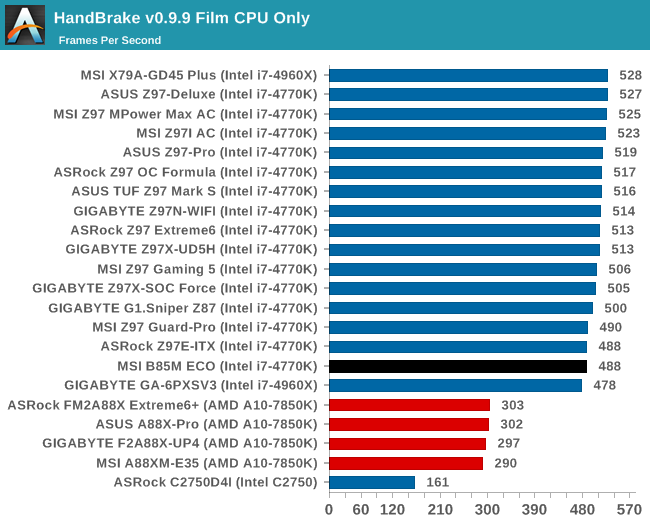
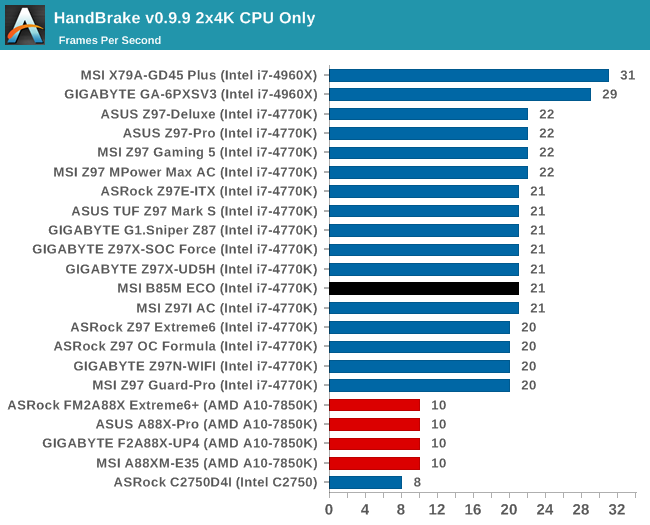
Rendering – PovRay 3.7: link
The Persistence of Vision RayTracer, or PovRay, is a freeware package for as the name suggests, ray tracing. It is a pure renderer, rather than modeling software, but the latest beta version contains a handy benchmark for stressing all processing threads on a platform. We have been using this test in motherboard reviews to test memory stability at various CPU speeds to good effect – if it passes the test, the IMC in the CPU is stable for a given CPU speed. As a CPU test, it runs for approximately 2-3 minutes on high end platforms.
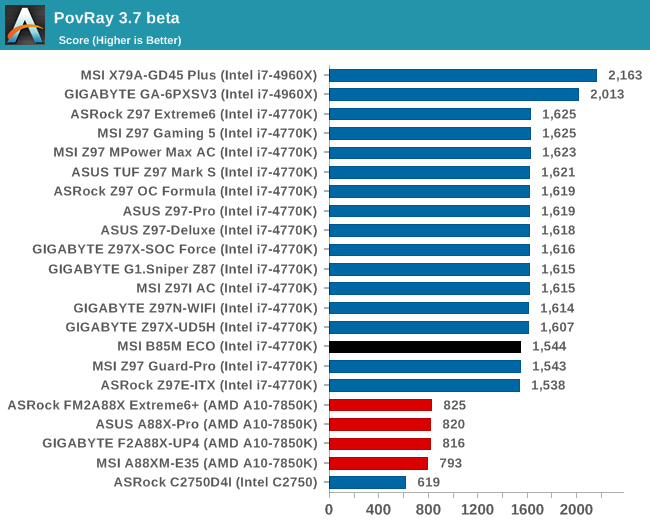
Synthetic – 7-Zip 9.2: link
As an open source compression tool, 7-Zip is a popular tool for making sets of files easier to handle and transfer. The software offers up its own benchmark, to which we report the result.
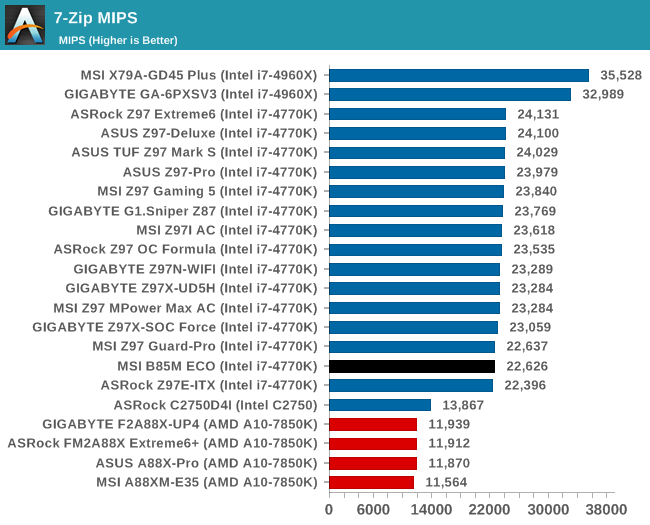










40 Comments
View All Comments
simonpschmitt - Wednesday, November 26, 2014 - link
I just found the board online for 68€ witch means one would break even after 2.2 Years.miksmi - Wednesday, November 26, 2014 - link
For servers, I moved to the mini-ITX form factor and am interested in an ECO version. I keep servers 8-10 years.hojnikb - Wednesday, November 26, 2014 - link
For office (and other non demanding uses) wouldn't it make more sense to go j1900 route rather than eco 1150 + celeron/pentium/i3 cpu ?It will use way less power than 1150 + fanless by default (even more power savings).
Ian Cutress - Wednesday, November 26, 2014 - link
For most office work, you're probably right. But a socketed platform does offer a potential upgrade path if the dynamics of the work change to something more computationally intensive. Also going down the LGA1150 route offers faster response times, which some businesses might argue is important when continuously dealing with emails and so on. It really depends on the scenario.Folterknecht - Wednesday, November 26, 2014 - link
"One of the points in the review was the inability to select a lower CPU voltage. Both voltage and frequency have a role in total system power consumption, but when full performance is still needed, voltage is the only variable left to modify. I posed this question to MSI, and received the following response:“We actually did try to do some testing with lower CPU voltage settings. The reason why we didn’t include it into the current BIOS is because we think Intel’s current FIVR architecture puts too many limits inside their design and we [would] rather use Intel’s integrated power saving features like C-State (Up to C7) and also SVID power. But it’s still a good suggestion that we can request our R&D to do more testing and check if we can fine tune better settings to enhance the power saving ability.”"
Lazy excuse in my book, considering that its still possible to undervolt current generation Intel CPUs quite a bit, at least when it comes to load voltage susually something between 0.1 - 0.2 V. As a MB manufacturer I can imagine that it would even be possible to play around with everything between idle and full load voltage, something a normal user cant do.
So instead of waisting their time on hot marketing air, develop something along the lines of auto-OC software or as an option in BIOS, but instead of overclocking let it undervolt the CPU automatically until it fails. But please no "1-2-3 click ready nonsense" of predefined values, more along the lines of a small stress test, which lowers the voltage by 0.02V or something like that after every sucessfull pass.
The perfect end result would be a bios voltage table (or in software), which fits the cpu installed - we all know the silicon lottery here. In an approach like this, lies much potential for saving energy.
andychow - Wednesday, November 26, 2014 - link
I've worked in the cubicles of many large corporations, and most people just log off their session or lock their screens at the end of the day, they don't turn the computer off. So cost savings would be even more interesting in these scenarios.piasabird - Wednesday, November 26, 2014 - link
So do unused ports and slots use power? Like if you use just 2 ddr3 SLOTS do the empty slots use power? Same with SATA and PCIE? So if the case is so why not use a MITX motherboard?piasabird - Wednesday, November 26, 2014 - link
You cant just look at the cost to run the motherboard. What about an eco friendly Monitor? Then there is the heat that is created to use the motherboard. During the summer or in say a server room something is cooling off the hot air.just4U - Wednesday, November 26, 2014 - link
Hi Ian,I hadn't really noticed that Anand wasn't reviewing business class motherboards. I picked up a H97 GAMING 3 MSI board for my wife a few weeks back.. certainly doesn't look like a business board.. but it does come with all the software. Maybe you will get a chance to review that one in coming months..
Anyway, on this one I almost thought it was a Sniper board at first geez.. GREEN.. Waiting to see your matx x99 review.. should be interesting!
Daniel Egger - Wednesday, November 26, 2014 - link
I LOLed when seeing the TÜV Logos. There're only few certifications like GS that follow a normed procedure. Other than that you can basically specify the test procedure and criteria, deliver the products (and a boatload of cash) and they will certify you that your products passed test procedures by the criteria you've specified. Very useful...The important point of information I'm missing here is: What were the tests? What were the passing criteria? Is there any competition which underwent the same certification and if so what were the results?